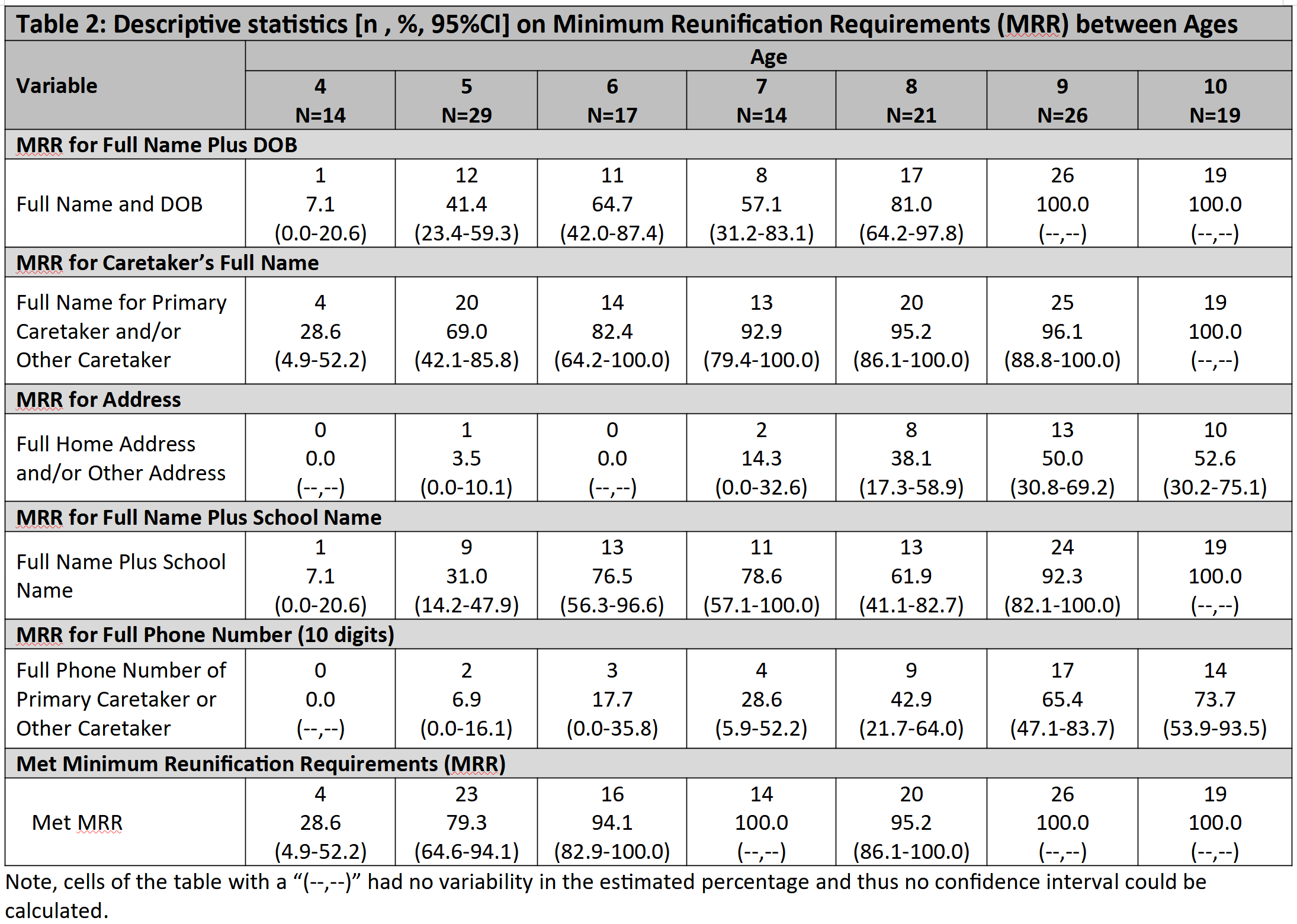Back
Public Health & Prevention
Category: Abstract Submission
Public Health & Prevention III
498 - Reunification of Displaced Children in a Disaster: Can Children Provide the Minimum Critical Identifying Information (CII) Required for Reunification?
Sunday, April 24, 2022
3:30 PM – 6:00 PM US MT
Poster Number: 498
Publication Number: 498.344
Publication Number: 498.344
Marcelo Lacayo, Medical College of Georgia at Augusta University, Grovetown, GA, United States; Natalie Lane, Medical College of Georgia at Augusta University, Evans, GA, United States; James A. Wilde, Medical College of Georgia at Augusta University, Augusta, GA, United States; Robert Gibson, Augusta University, Augusta, GA, United States; Andrew J. Pless, Medical College of Georgia at Augusta University, Cordele, GA, United States

Marcelo Lacayo, MD
Pediatric Emergency Medicine Fellow
Medical College of Georgia at Augusta University
Grovetown, Georgia, United States
Presenting Author(s)
Background: The challenge of reunifying children with family members after being displaced during a disaster can be complicated by the child’s ability to accurately report personal identifying information.
Objective: In this study, we assessed the ability of children to provide Minimum Reunification Requirements (MRR) to reunite them with their caretakers.
Design/Methods: This IRB approved, cross sectional study employing a convenience sample, was conducted at Children’s Hospital of Georgia Pediatric ED, affiliated to Augusta University. Inclusion criteria included: English speaking, with no illness that could impede data collection, and being accompanied by their caretakers. Caretakers provided their child’s CII (see Table 1) in written form. The child was then asked for their CII verbally, referencing the caretaker’s response for accuracy. Frequencies, percentages and 95% confidence intervals (CI)] were determined for all variables by age and combined age groups (4-5, 6-8, and 9-10). A one-factor generalized estimating equation model using a binomial distribution and identity link was used to examine differences between age groups for the mean percent having the ability to provide each CII as well as the ability to be unified outcome. A Tukey-Kramer multiple comparison test was used to examine differences between age groups to account for the multiple comparisons. Table 1 provides definitions of CII and MRR.
Results: A total of 154 4-10 year old children were interviewed.140 responses were suitable for analysis. Across ages CII scores increased indicating increasing knowledge of CII with age. Children provided at least one MRR in 28.6%, 79.3%, 94.1%, 100%, 95.2%, 100% and 100% of cases, respectively. The MRR which was most known by our cohort was Name of Caretaker (28.6% to 100% of children) and the least known was Full Address (0% to 52.6% of children). Largest gains in knowledge of MRR was between ages 6-8. See Table 2 and Chart 1 for additional data.Conclusion(s): Our study demonstrated age related variability of MRR and highlights that reunification will be most problematic in children 6 and under. Efforts to increase MRR should be focused on this group. Further research can be directed toward children’s ability to learn and retain meaningful MRR information. Limitations include lack of an actual disaster setting with a concomitant high level of stress. Additionally, we did not ask about other, possibly interrelated, issues such as parental education level, race, sex, and school grades, all of which may play a role in MRR reporting.
Critical Identifying Information (CII) and Minimum Reunification Requirements (MRR).png) CII refers to different elements within personal information, including name and dob, names of caretakers, relevant addresses, school name, and relevant phone numbers . MRR refers to the minimum cluster of CII elements required for emergency providers to reunite a child with their caretakers.
CII refers to different elements within personal information, including name and dob, names of caretakers, relevant addresses, school name, and relevant phone numbers . MRR refers to the minimum cluster of CII elements required for emergency providers to reunite a child with their caretakers.
Descriptive Statistics for Minimum Reunification Requirements (MRR) between Ages From 4 to 10 years of age children demonstrated further additional knowledge of MRR.
From 4 to 10 years of age children demonstrated further additional knowledge of MRR.
Objective: In this study, we assessed the ability of children to provide Minimum Reunification Requirements (MRR) to reunite them with their caretakers.
Design/Methods: This IRB approved, cross sectional study employing a convenience sample, was conducted at Children’s Hospital of Georgia Pediatric ED, affiliated to Augusta University. Inclusion criteria included: English speaking, with no illness that could impede data collection, and being accompanied by their caretakers. Caretakers provided their child’s CII (see Table 1) in written form. The child was then asked for their CII verbally, referencing the caretaker’s response for accuracy. Frequencies, percentages and 95% confidence intervals (CI)] were determined for all variables by age and combined age groups (4-5, 6-8, and 9-10). A one-factor generalized estimating equation model using a binomial distribution and identity link was used to examine differences between age groups for the mean percent having the ability to provide each CII as well as the ability to be unified outcome. A Tukey-Kramer multiple comparison test was used to examine differences between age groups to account for the multiple comparisons. Table 1 provides definitions of CII and MRR.
Results: A total of 154 4-10 year old children were interviewed.140 responses were suitable for analysis. Across ages CII scores increased indicating increasing knowledge of CII with age. Children provided at least one MRR in 28.6%, 79.3%, 94.1%, 100%, 95.2%, 100% and 100% of cases, respectively. The MRR which was most known by our cohort was Name of Caretaker (28.6% to 100% of children) and the least known was Full Address (0% to 52.6% of children). Largest gains in knowledge of MRR was between ages 6-8. See Table 2 and Chart 1 for additional data.Conclusion(s): Our study demonstrated age related variability of MRR and highlights that reunification will be most problematic in children 6 and under. Efforts to increase MRR should be focused on this group. Further research can be directed toward children’s ability to learn and retain meaningful MRR information. Limitations include lack of an actual disaster setting with a concomitant high level of stress. Additionally, we did not ask about other, possibly interrelated, issues such as parental education level, race, sex, and school grades, all of which may play a role in MRR reporting.
Critical Identifying Information (CII) and Minimum Reunification Requirements (MRR)
.png) CII refers to different elements within personal information, including name and dob, names of caretakers, relevant addresses, school name, and relevant phone numbers . MRR refers to the minimum cluster of CII elements required for emergency providers to reunite a child with their caretakers.
CII refers to different elements within personal information, including name and dob, names of caretakers, relevant addresses, school name, and relevant phone numbers . MRR refers to the minimum cluster of CII elements required for emergency providers to reunite a child with their caretakers.Descriptive Statistics for Minimum Reunification Requirements (MRR) between Ages
 From 4 to 10 years of age children demonstrated further additional knowledge of MRR.
From 4 to 10 years of age children demonstrated further additional knowledge of MRR.